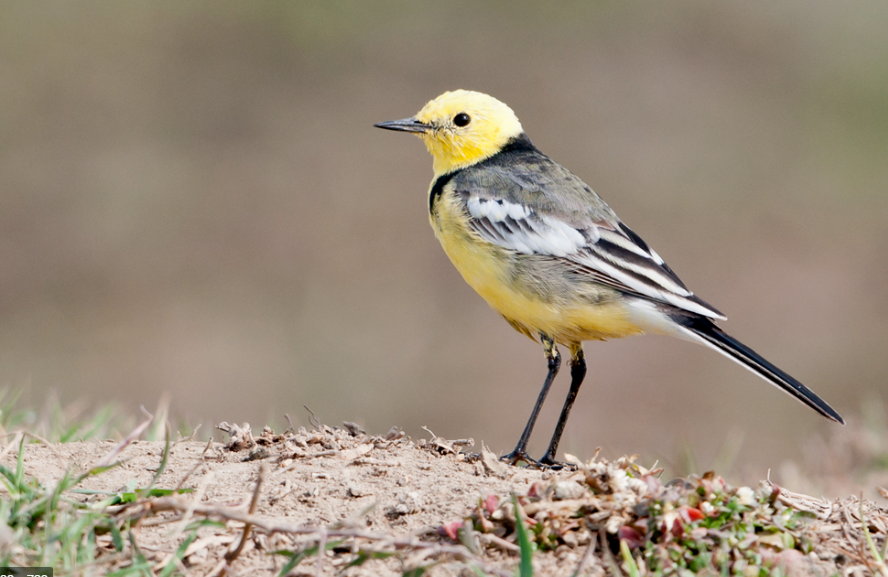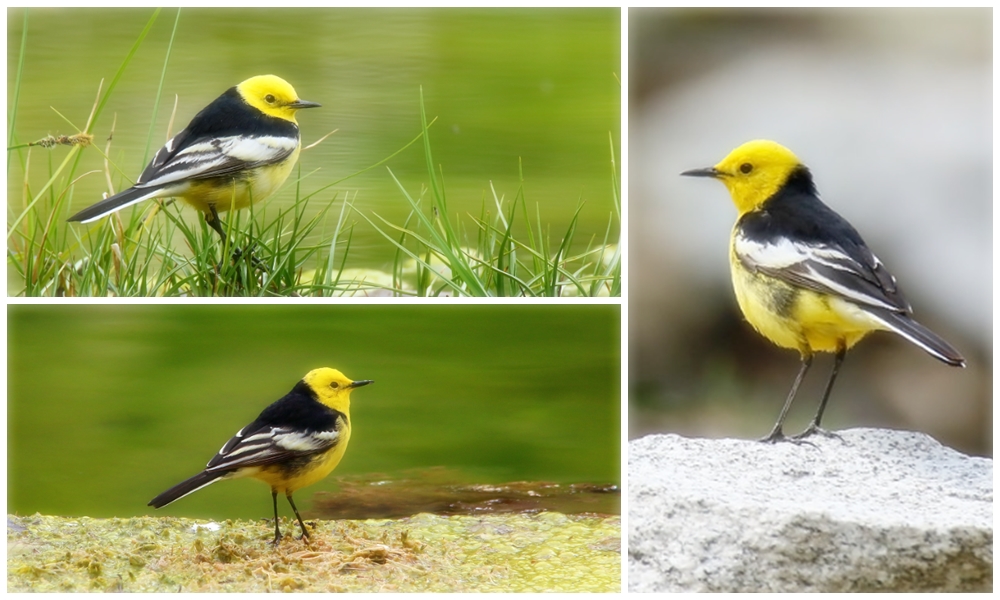Page Contents
Citrine Wagtail Identification
The male adult bird summer unmistakable, with canary-yellow head and underparts, gray upperparts, black lower nape (extending to sides of the neck), and high up white wing bars (latter reduced with wear). Some male birds of this race lutea of Yellow Wagtail have all yellow heads, but these have olive (not gray) upper parts and lack diagnostic black half-collar.
Also, the male adult bird winter and adult female are a little duller, with the grayish ear-coverts, crown, nape, and habitually breast sides and flanks. It is distinguished from Yellow (particularly summer males of races flavissima or lutea, which are closest) by dull ashy-gray upperparts and breast sides, and broad yellow supercilium that curves down behind ear-coverts to join yellow throat (so framing ear-coverts) and often yellowish forehead. (Note that rarely the supercilium frames the ear-coverts in Yellow too, but more diffusely.)
The lore is pale or diffusely dusky, while Yellow usually (but not always) shows a dark loral line. (Note: many lutea have pale lore, but.) It does not show a prominent, clearly defined yellow stripe across lower ear coverts approximating many adult male flavissima and some lutea. Yellow coloration is frequently bright only on the head and throat, paling from breast downwards, and under the tail, coverts are always whitish (Yellow Wagtail is uniform yellow below).
The wing bars are usually broad and white (typically narrow and yellowish tinged in Yellow), but may become narrow with wear; beware of occasional Yellow with fairly broad, whitish wing bars. Juvenile White Wagtails with a yellow wash to face can suggest adult female or winter male Citrine, but these have black breast band (juvenile Citrine also has breast band, but no yellow on the head), longer tail, and different call. Juvenile is virtual as juvenile Yellow, but supercilium is broader, wing bars are broader and whiter, and edges to secondaries are whitish rather than yellowish.
The first-winter birds in autumn are dull ashy-grey on upper parts, with a wash of similar color on breast sides and flanks, and vestiges of juvenile dusky malar stripe and gorget remaining as a dark mark at sides of the neck and a few weak breast spots. Although weak buff tones may be apparent on the head and breast, they basically appear grey and white, and completely lack yellow (which first appears on the head in late winter). Closely resembles first-winter female Yellow, but most of these shows a greenish tinge above and some yellow below, especially on upper tail coverts.

However, they may be matched in color by some very ‘grey and white’ Yellows, especially those of beema and some other eastern races that show no greenish tinge above or yellow below. While these are slightly lighter and more grey-brown above than Citrine, they are highly problematic, and best distinguished by head pattern.
In Citrine, the forehead is usually paler than the crown (being pale brown or buff) and the supercilium is markedly broader, especially above and behind the eye (maybe brownish and diffuse in front of the eye), usually extending round in a curve to frame the ear-coverts (although this extension sometimes weak or lacking, and less apparent when neck hunched).
In Yellow, the forehead is not obviously paler than the crown, the supercilium is narrower (and more distinct and less brownish in front of the eye) and does not curl down to frame the ear-coverts (which merge with the nape). In addition, Citrine has lore pale or at most diffusely dusky (Yellow shows a distinctive dark loral line, but beware of effects of shadow on Citrine) and there is a darker shade along the sides of the crown.
That is forming a dark upper border to the supercilium (but note that the latter feature is occasionally seen in first-winter Yellow, and routinely present, even more prominently, in juvenile Yellow); further, the ear coverts are never uniformly dark (as in some first-winter Yellows) but nor do they show broad pale stripe birds, however, show intermediate head patterning; these are perhaps variant Citrines (perhaps only of race werae) rather than Yellows, but maybe a result of occasional hybridization.
In fresh juvenile plumage, the wing bars and tertial edges of young Citrine are broad and very white, but these become less conspicuous with wear and even on Yellow they may be striking when plumage fresh; tips of any newly molted, first-winter, median or greater coverts in autumn are paler, less brownish-tinged, than in any newly molted coverts worn by young Yellow. Bill of Citrine is largely dark, whereas young Yellow usually has an extensive pale base to the lower mandible.
Although Citrine’s call is different from that of Yellow, regional variation in calls of Yellow can cause confusion, especially with late-autumn birds which may be migrants from unfamiliar populations. Citrine is more closely attached to watersides, found less in grassland, than Yellow, but individuals freely associate with migrating Yellows and mixed pairings of vagrant male Citrine and female Yellow have been reported several times in W Europe. Compare also Grey Wagtail.
Sex/Age
Sexes differ. For a few summer females have yellow forehead and ear-coverts, and trace of black half-collar, recalling 1st-summer male. Winter male resembles female, but wing bars considerably broader and whiter when fresh, and most of the underparts, forehead, and ear-coverts usually yellow (latter often outlined with dark); may show a trace of black half-collar.
Yellow is tinged with buff in some females. From late autumn, sexing becomes more difficult owing to feather wear. Juvenile very similar to juvenile Yellow, lacking yellow in plumage and being browner above than adult female; has dark gorget and dark upper border to pale supercilium.
Upper parts become greyer and dusky gorget and facial pattern almost lost by autumn as First-winter plumage steadily adopted (see Identification); yellow begins to appear on the head by late winter, after which aging difficult owing to wear and individual variation.
First-summer birds are often duller than adults, males frequently having some grayish feathering on the crown, less distinct black half-collar, and paler yellow tone to head and underparts; First-summer females are also often duller, with wings more abraded than adult females.

Citrine Wagtail Call/Voice
Citrine wagtail’s typical call resembles that of Yellow Wagtail, but, compared with NW European races, is a distinctly louder, slightly shorter, more rasping, slurred ‘dzreeip’ or ‘tzreep’. However, the calls of Yellow wagtail vary geographically, however, and some southern and eastern races have more rasping calls than NW European populations, with some of the eastern forms sounding very like Citrine.
Song
Moreover, the song of the Citrine wagtail, given from perch or in a short flight, is based on repeated calling with warbling phrases interspersed in the songbird family of Motacillidae.
Citrine Wagtail vs Yellow wagtail
The citrine wagtail (Motacilla citreola) structure is very close to the Yellow wagtail (Motacilla flava), although marginally plumper, with a slightly longer tail, longer legs, and stouter bill, but differences are slight and overlapped by variation within the Yellow Wagtail complex.

Geographical Variation
There are two races as per geographical variation. Male birds are slightly smaller southern race werae breeds Poland and Turkey eastwards are paler yellow on head and underparts than nominate race and purer and lighter grey above, with narrower black nape patch and less grey on flanks. The female birds are also slightly paler, but doubtfully separable.
Habitats
Citrine wagtail is locally a common bird. Its breeding range is steadily extending to the west. In addition to the mapped range, has bred Finland and Czech Republic, and also elsewhere when paired with Yellow Wagtail.) The bird is a rare passage migrant through the Middle East with Yellow Wagtails, sometimes wintering in Israel. Mostly winters in Iran, Arabian Peninsula, and S Asia.)
Citrine wagtail breeds on marshy tundra with willow thickets, montane meadows, peat bogs, and scrubby water meadows. Outside breeding season can occur in any sort of moist open habitat, preferably with pools and streams, lakesides, fishponds, ditches, etc.
Wagtail breeding densities are highest in open, food-rich agricultural areas, whereas roads and urban areas influence their breeding densities negatively. Fauna strips, as an agricultural nature conservation measure, function for Wagtails as a habitat with the highest food abundance.
Other Name & Size
Citrine wagtail is also known as Yellow-hooded wagtail with a size of 16-17 cm in length constantly wagging tail. This beautiful bird is called সিট্রিন খঞ্জন in Bangali.
